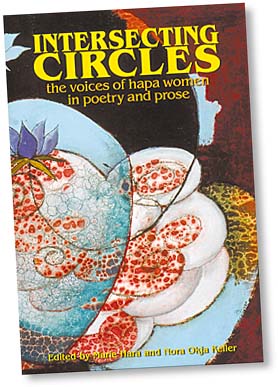Advertisement - Click to support our sponsors.


"Intersecting Circles: The voices
of hapa women in poetry and prose,"
edited by Marie Hara and Nora Okja Keller
(Bamboo Ridge Press), paper, 396 pages, $18Blood sisters
'Intersecting Circles'
By Cynthia Oi
gives insight into the
hapa experience
Star-BulletinMARIE Murphy Hara and Nora Okja Keller are part-white, part-Asian women who have put together a collection of works by women who also are part white and part something else, or all part something else.
The book is called "Intersecting Circles: the voices of hapa women in poetry and prose," and it is exactly what the title says.
The idea for it came about because of who the editors are: writers who are women who are of mixed race who "saw how important ethnicity was for us in terms of finding our voices," Hara said.
"We are trying to expand this idea of hapa apart from this imposed idea that we are either a bridge between cultures or are stuck between the cracks," said Keller in a separate interview.
The book contains more than 60 pieces -- personal essays, poems, short stories and excerpts from longer works -- by such writers as Jessica Hagedorn, Karla Brundage, Susan Miho Nunes, Kathleen Tyau, Kathy Song, Noelle M.K.Y. Kahanu, Velina Hasu Houston, Cynthia Nakashima and Sabrena Taylor.
Hara grew up in a time when being hapa was difficult. As she writes in her introduction, "... I was born when my existence was still stigmatized. ... Hapa haoles, for example, were often marginalized figures with a questionable role, depending on social standing, admired and reviled at once."
LISTEN UP
What: Readings from "Intersecting Circles"
When: 7:30 p.m. tomorrow at the University of Hawaii at Manoa, Campus Center Ballroom; noon Wednesday, Kapiolani Community College Ohia 118; 7 p.m. April 6, Japanese Cultural Center of Hawaii, room 102
Call: 626-1481
Keller, at 34 two decades Hara's junior, encountered a different attitude. When she was young, she writes, "hapa was hip. In Honolulu during the '70s and '80s 'Eurasian' was considered beautiful, cosmopolitan, exotic."
Still, when she married a white, she encountered resistance from the Asian-American communities who thought she was further diluting her Asian roots. " 'Your kids will be even less Korean,' " was the comment.
As a young woman, Hara also was noticed for her looks, hired as a Playboy bunny "filling a quota slot for, in their words, 'an exotic type.'


"I bought into the stereotype; it was the best role around at the time for someone like me, someone missing validation," she writes.The missing validation came with the push and pull of being unacceptable in both Japanese and haole worlds.
"When you start choosing sides, in some ways you're throwing away a part of yourself," she said. "You're foregrounding one thing over another, but you may not be only that thing."
At the same time, passing for one or the other flattened her self-identity further.
"You became someone who was so discriminated against that you often decided that the only way to live was to put aside, submerge another."
The writers in the collection explore a spectrum of emotions, problems, viewpoints and perceptions, but they are all women.
The editors said there a number of reasons to publish women only.
"We felt that a lot of times, culture is passed through maternal lines," Keller said.
"Mothers do the daily kind of teaching," Hara said, "through food, manners, language, traditions."
More practically, Keller said, "Six or seven years ago when we first started collecting information, there weren't a lot of hapa men who were writing."
With interracial marriage becoming increasingly common, Hara said she hopes people will just get over the race thing.
"The yellow, the black, the white, the Mongoloid, the Caucasoid -- this whole way race is setup," she said, exasperated. "This is 18th century thinking."
Besides, now scientists are discovering that modern humans, no matter what color, share more genetic history that previously thought, she said.
"Being hapa totally disintegrates all those easy categories of race," Keller said. "There is a danger and maybe a denial in believing that there is not possibility of crossovers."
She recently saw a news program during which a student from Bob Jones University, where interracial dating was banned until March 6, was interviewed. The young man said he had nothing against "these" people, but "whites are whites, Asians are Asians and blacks are blacks."
Keller said she hopes maybe one student at Bob Jones will pick up "Intersecting Circles" and discover, "Oh, I felt this way or find some aspect in themselves that they can recognize and realize that we are so much more interconnected than we could ever imagine."
Even without that recognition, Keller believes the book worthy.
"I look at some of the stuff in the anthology and think that's not my experience. But that's what's nice. It's just a condition of being human -- we are so curious about other perspectives."
Click for online
calendars and events.